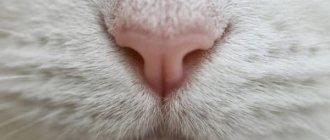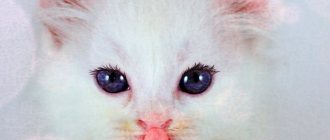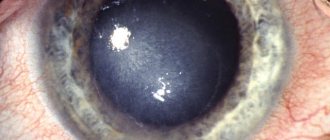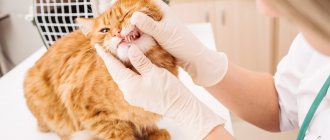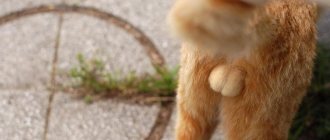If a cat has blood in the eye, this may be a sign of ailments such as dacryocystitis, traumatic injuries, neoplasms of the lacrimal glands, or hyphema. Any disease is accompanied by decreased vision and severe anxiety of the animal. At the first symptoms, your pet should be taken to a veterinarian, who will diagnose and prescribe treatment.
According to veterinary ophthalmologist O. Fedotova, eye injuries disrupt hydrodynamics and can lead to blindness.
Why is my cat bleeding from his eye?
Dacryocystitis
The disease is characterized by inflammation of the lacrimal sac, which can be congenital and diagnosed in kittens, or acquired, developing against the background of other diseases. Most often, dacryocystitis is caused by sinus infections. Due to the inflammatory process, the circulation of tear fluid is disrupted. The mucous membranes swell and the blood vessels located in them can burst, causing bloody discharge from the eyes. Symptoms:
- the appearance of mucopurulent discharge;
- redness of the conjunctiva;
- swelling in the area of the lacrimal sac;
- soreness;
- blurred vision;
- slight increase in temperature.
Traumatic injuries
This symptom is typical for animals that have suffered visual injuries during a fight with their fellow animal.
Bloody discharge in a cat appears as a result of an open injury to the organ of vision during a fight with relatives, or a strong blow to the eye area with a heavy object. The cause of hemorrhage is also the entry of a foreign body - wood or metal specks, glass. A cat may scratch its eye when washing itself. There is a rupture of the eye membranes, displacement of the lens. When the orbit is fractured, the structures of the eye are damaged by bone fragments. The kitten is injured while playing with sharp toys, and damage can also be caused by the cat carelessly washing or restraining the baby. Signs:
- bleeding;
- displacement or prolapse of the eyeball;
- severe pain and shock;
- corneal clouding;
- tears flow profusely;
- swelling of surrounding tissues.
Neoplasms of the lacrimal glands
Bloody tears from the eyes of a cat appear due to phlegmon, when pathogenic microbes enter the orbit or an abscess due to advanced inflammation of the lacrimal gland. Tumors also arise when metastases spread from surrounding foci. Manifestation:
With this disease, the cornea of the organ may become cloudy.
- strong pain;
- temperature increase;
- discharge from the eyes mixed with blood;
- change in organ color;
- impaired motor function of the eyeball;
- swelling of the conjunctiva;
- corneal clouding;
- decreased or lack of appetite;
- blurred vision.
Hyphema (bleeding into the eye chamber)
The pathology develops against the background of injuries, inflammation of the choroid or iris, due to high blood pressure, diabetes, and also as a complication after surgery. Blood accumulates in the anterior chamber of the lower part of the eyeball, so it is visually felt that the cat’s eyes are filled with bloody fluid. Signs:
- pain syndrome;
- increased reaction to light;
- decreased vision;
- intraocular hypertension.
Nasal discharge
A cat's nose cleans the inhaled air of dust and other contaminants. But in addition to air, the animal can inhale pathogenic bacteria and viruses. The nose filters them out, preventing them from entering the body. Dust and microbes settle on the mucous membrane, forming dark thin crusts. They are released through the nose while washing. Such discharge is not a sign of illness, but a normal phenomenon for the animal.
A cat can also inhale a foreign body - an insect, a small bone, a thread, etc. In this case, he begins to sneeze, as a result of which the foreign particle comes out of the nose on its own. If the foreign object does not come out, under no circumstances try to remove it yourself (you can seriously damage the mucous membrane), but show the cat to a veterinarian.
Copious nasal discharge, accompanied by sneezing and heavy breathing, indicates a serious illness in the cat, because pathogens of incurable diseases - leukemia and peritonitis - can enter the animal’s body through the nose. Only timely vaccinations can protect a pet from them.
Diagnostics
The animal must undergo an ophthalmoscopy of the diseased organ.
If a cat has a swollen eye and a bloody trail is observed, the veterinarian finds out the possible cause of the condition, conducts an external examination and prescribes diagnostic procedures, such as:
- ophthalmoscopy;
- radiography;
- measurement of intraocular and blood pressure;
- electroretinogram;
- microscopy;
- fluorescein test;
- Ultrasound of ocular structures.
Prevention
Of course, every cat can encounter diseases of the organs of vision, but the owner’s task is to do everything possible to ensure that the risks of such diseases are as low as possible. To do this, you need to provide your pet's eyes with proper care.
To prevent bacteria from growing in the mucus that periodically accumulates in the corners of your cat's eyes, the mucus must be removed periodically. To do this, you can use special disinfecting eye lotions or herbal decoctions.
When washing your beloved cat, it is necessary that the soap solution and water do not get into the eyes and do not irritate them. The same precautions should be taken when treating fleas and other parasites with insecticidal drops and powders. If your pet has long hair, you need to pay attention to the length of the hair above the eyes. If the fur hangs down, it can scratch the animal's delicate conjunctiva, damage the eyes and, as a result, cause blood in the eye.
The owner should be extremely careful when carrying out any procedures with the cat's eyes, so as not to scratch or damage the delicate organ. Do not use dry wipes or cotton wool, as their fibers may get into your eyes. It is better to moisten a napkin or cotton wool in a special eye cleansing solution or in a weak chamomile decoction.
What to do if there is blood coming from the eye?
The treatment regimen is prescribed by a veterinarian; self-medication leads to loss of vision for the pet. Tumors and cellulitis are removed through surgery. To suppress bacteria, antibiotics are used, which the veterinarian prescribes individually. Surgery also needs to be done for injuries, when the veterinarian removes a foreign body from an organ. In severe cases, enucleation is performed and the eyelids are sutured. If one eye is swollen and bleeding due to dacryocystitis, the lacrimal sac is washed with boric acid or solutions of Furacilin, Protargol. If therapy is ineffective, surgery is recommended. Hyphema, which occurs against the background of other pathologies, is cured when the main cause of the hemorrhage is eliminated. Sore eyes in kittens and adult cats should be treated daily with antiseptic eye products.
Washing
It takes two people to help a cat with watery eyes. Holding it tightly and at the same time carefully rinsing the eye alone will not work.
For the procedure, make any antiseptic solution without alcohol: you can take furatsilin, chamomile or oak bark. The liquid should not be hot and slightly concentrated.
One person should hold the pet firmly to prevent it from twitching. You can take her on your lap: if it is the owner, the cat will smell him and calm down. Hold her paws with one hand and hold her head with the other.
The second person will need a gauze swab or cotton pad and a prepared warm solution. Soak the swab in the broth and squeeze it out lightly, then gently rub it over the animal’s eye. Make sure your cat is not in pain from this procedure, especially if she is bleeding.
Repeat wiping until the new swab is clean.
If your cat's eyelids are stuck together due to the amount of discharge, then you can apply an unwrung swab to the eye and leave it for a while. Warm liquid will quickly help the eye open, and after that you can rinse the eye.
After the procedure, you can put tetracycline ointment under the eyelid. It will help relieve inflammation and make the cat feel a little better.
Possible complications of the disease
Prolonged ignoring of pathology leads to serious complications:
- anosmia - partial or complete loss of smell;
- decreased local immunity;
- inflammation of the trachea, larynx, ears, eyeballs;
- deterioration of memory and intelligence;
- hearing problems;
- nasal deformity;
- pneumonia;
- meningitis;
- gastrointestinal dysfunction: nausea, vomiting, dyspepsia, gastritis;
- depressive states, apathy, neurasthenia.
The most difficult consequence of pathology is the spread of the atrophic process to other organs.
Unfortunately, people often turn to an otolaryngologist with an already advanced form of atrophic dry rhinitis. The doctor prescribes treatment that can make the patient feel better and stop the development of the pathology, but it is no longer possible to return the nasal cavity to a completely healthy state.
If you find at least one symptom of a disorder of the mucous membrane, then you need to contact a qualified specialist. This will allow you to diagnose the disease in time and take the necessary measures to treat it.
Reasons for the development of the disease
We list the common causes that contribute to the occurrence of the disease:
- Heredity: often the disease is passed on from generation to generation.
- Repeated viral or bacterial infections contribute to atrophy of the nasal mucosa.
- Hormonal imbalances, such as endocrine system disorders, that occur in a teenager's body during puberty.
- Trauma and surgery.
- Lack of vitamin D and iron in the body.
- Impact of stress factors.
- Harmful environmental conditions:
- tobacco smoke,
- chemical vapors
- dust and smoke in the air,
- prolonged inhalation of hot or cold air.
Long-term use of vasoconstrictor drops can also cause atrophic rhinitis.
It should be noted that identifying a specific cause that provoked the disease increases the effectiveness of treatment.
What to do at home
To treat your pet's tearfulness or relieve symptoms, there are a number of steps you can take at home. If you are sure that the cat is not in danger, and it is an allergy or a mild bruise, you can wipe or rinse your pet’s eyes yourself.
Usually a weak solution of furatsilin (0.2%), chamomile decoction or even black tea is prescribed, which has a calming and disinfecting effect.
It is also recommended to make compresses from a decoction of sage, calendula and St. John's wort.
INSTRUCTIONS: How to carry out treatment prescribed by a doctor at home. You will need: a cotton pad/cotton wool, a handkerchief, a pipette/syringe without a needle and your patience and skill. Before starting the procedure, be sure to wash your hands under running water and soap. Hold the cat in your arms or on your lap.
In order to protect both you and the animal from unnecessary injuries, it will be useful to “secure” it with a scarf, or ask someone to help hold it. Be sure to talk to your cat, reassure him, and let him know that you want to help him. Soak a cotton pad in the solution and carefully moisten the resulting crust around the eyes, and remove all excess with a second circle.
Re-wipe the eye area with another clean pad soaked in water. To drop the medicine into the eyes, do the same: grab and place the cat on your lap, carefully open the eyelid with your fingers, and with the other hand, drop the medicine inside (under the eyelids or in the upper corner of the eye).
After completing all manipulations, remove any remaining medicine or ointment. As moral compensation, you can give your pet a treat.
IMPORTANT: Never use potassium permanganate solution to wash your eyes. Although it is known as an excellent disinfectant, it can damage the integrity of the eye crystalline through a burn.
How to treat atrophic rhinitis
The therapy process is quite lengthy and requires persistence on the part of the patient. Treatment of atrophic rhinitis in adults and children is prescribed only by a qualified otolaryngologist and includes the following procedures:
- Rinsing the nasal cavity with saline components. It is necessary to use the safe and effective product “Sialor Aqua”. The nasal mucosa should be irrigated with this drug regularly. The sterile sea water included in the composition moisturizes and cleanses the nasal cavity from dust, allergens, infections, and also helps soften and remove some of the crusts. Sea salt has an antiseptic and anti-edematous effect, strengthens blood vessels, and accelerates the healing process of microcracks and damage.
- Moisturizing the nasal mucosa. For minor symptoms of atrophic rhinitis and detection of the disease at an early stage, oil products are used.
- Symptomatic treatment. In order to thin the mucus, the patient is prescribed alkaline solutions for instillation into the nose or inhalation. Mucolytics are also used to facilitate the removal of sputum. To eliminate atrophic symptoms, accelerate tissue regeneration and improve metabolism, various ointments are used.
- Course treatment with antibiotics. If the underlying cause of the disease is a bacterial infection, the doctor prescribes medications depending on the type of pathogen. Antibiotics are selected individually and administered locally via inhalation. Self-administration of antibiotic therapy is prohibited. If rhinitis was caused by hormonal imbalance or vitamin deficiency, these drugs will only worsen the situation.
- Washing with antiseptics. To treat the nasal cavity covered with purulent mucus, hydrogen peroxide, soda solutions, and potassium permanganate are used.
- Biogenic stimulants improve the patient’s well-being and the condition of the mucous membranes. B vitamins are administered intramuscularly, and injections of placenta extract are used.
- Therapy with iron-containing drugs. It is prescribed if one of the causes of the disease is iron deficiency.
- Physiotherapy. The following methods help speed up the healing process: electrophoresis, magnetic therapy, UV irradiation.
- Surgical methods are indicated for patients who require treatment of chronic atrophic rhinitis with obvious atrophy of the bone frame. Surgical actions are aimed at narrowing the nasal cavity artificially for up to six months. This is necessary for healing the mucous membranes. The surgical method is an extreme, but very effective measure.
It should be noted that patients with atrophic rhinitis living in a dry climate are recommended to move to regions with a high degree of humidity. In winter, it is advisable to use portable air humidifiers indoors to avoid relapses of the disease.
It is impossible to return to the excellent condition of the mucous membrane with a fetid runny nose (ozena). All known treatment methods give a temporary effect, and after cessation of therapy, the symptoms of the pathology return. Therefore, it is better to avoid complications of atrophic rhinitis and start therapy in a timely manner.

